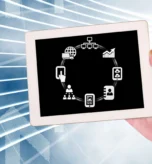Top ERP Software Development Mistakes That Cost Businesses Time and Money

By Rayblaze Global Private Limited
Enterprise Resource Planning (ERP) software is the backbone of modern business operations. It streamlines workflows, improves visibility, and unifies departments across finance, HR, inventory, procurement, and more. But ERP software development is also notoriously complex and fraught with risk. One misstep can lead to spiraling costs, delayed timelines, and a solution that doesn’t meet business needs. A 2023 report by Panorama Consulting found that 52% of ERP implementations experienced cost overruns, and 54% exceeded their planned schedules. The root of many of these failures? Avoidable development mistakes. Whether you’re a business owner overseeing a digital transformation or a CTO managing internal development, understanding these common pitfalls is crucial. In this article, we unpack the top ERP software development mistakes that can burn time, money, and morale — and offer actionable insights to avoid them.
1. Unclear Business Requirements and Objectives
One of the earliest and most costly mistakes is failing to define clear, measurable goals for the ERP system.
Why It Happens:
- Business stakeholders and IT teams operate in silos.
- Vague objectives like “improve efficiency” without KPIs.
- Assumptions that ERP vendors will figure out requirements.
The Impact:
- Misaligned features
- Development rework
- Dissatisfied end-users
Solution:
Involve all stakeholders — including end-users — early in the requirement-gathering process. Document both high-level business goals and granular functional requirements. Use tools like MoSCoW (Must have, Should have, Could have, Won’t have) prioritization.
2. Over-Customization of ERP Modules
ERP systems offer robust out-of-the-box capabilities. But many businesses fall into the trap of over-customizing, trying to force the software to mirror their existing workflows.
Why It Happens:
- Resistance to change from legacy processes
- A belief that customization equals competitiveness
- Pressure from internal departments to tweak modules
The Impact:
- Increased development time and costs
- Harder maintenance and upgrades
- Vendor support limitations
Solution:
Standardize processes where possible to match ERP best practices. Customize only when it offers a clear business advantage or solves a unique problem. Always weigh the cost of customization vs. long-term benefits.
Stat: According to Gartner, businesses that heavily customize ERP systems spend 60% more on implementation and maintenance than those that adapt to standard configurations.
3. Ignoring Change Management and User Adoption
Even the most powerful ERP system will fall flat if users don’t know how (or refuse) to use it.
Why It Happens:
- Insufficient communication about the “why” behind the new system
- Inadequate training and onboarding
- Fear of job disruption among employees
The Impact:
- Low system adoption rates
- Shadow IT usage (employees using unauthorized tools)
- Delays in realizing ROI
Solution:
Invest in change management from day one — not just post-launch. Communicate benefits in business terms to different user groups. Offer continuous training, not just one-time sessions.
A study by Prosci shows that projects with excellent change management are 6x more likely to meet objectives than those with poor change management.
4. Choosing the Wrong ERP Development Partner or Vendor
Whether you’re building a custom ERP from scratch or configuring an off-the-shelf solution, your choice of development partner or vendor can make or break the project.
Why It Happens:
- Decisions made based on cost alone
- Lack of industry-specific expertise
- Overpromising by vendors during sales pitches
The Impact:
- Missed deadlines
- Poor-quality code or integrations
- Inability to scale the solution
Solution:
Evaluate vendors based on domain expertise, client references, and post-deployment support. Conduct technical due diligence. Ensure the partner understands your business model and compliance needs.
Ask vendors to walk you through post-go-live support plans, not just implementation timelines.
5. Poor Integration Planning with Existing Systems
An ERP system doesn’t operate in a vacuum. It must connect seamlessly with existing applications like CRM, inventory management, and third-party APIs.
Why It Happens:
- Integration is treated as an afterthought
- Lack of API readiness in legacy systems
- Underestimating the complexity of data flows
The Impact:
- Data silos and duplicate records
- Manual workarounds
- Broken workflows
Solution:
Map out data flows and dependencies early in the project. Ensure your ERP system (or custom code) supports integration standards like REST, SOAP, or GraphQL. Consider middleware solutions if direct integration is complex.
Stat: According to Deloitte, 43% of ERP failures are caused by data integration issues.
6. Underestimating Data Migration Challenges
ERP success hinges on clean, usable data. But many projects assume migration is as simple as exporting and importing spreadsheets.
Why It Happens:
- Data scattered across legacy systems
- Inconsistent data standards and duplication
- No clear data ownership
The Impact:
- Dirty data leads to poor decision-making
- Go-live delays due to incomplete data
- Frustrated end-users
Solution:
Start data cleansing and migration early — ideally during the planning phase. Define ownership of data by department. Test migrations using sandbox environments before full cutover.
7. Inadequate Testing Before Go-Live
Testing is often compressed into a short window just before the launch — a recipe for disaster.
Why It Happens:
- Pressure to meet launch dates
- Lack of test cases that reflect real-world usage
- Overconfidence in development quality
The Impact:
- Hidden bugs emerge post-launch
- Business disruption
- Costly emergency fixes
Solution:
Implement a phased testing strategy: unit testing, integration testing, UAT (user acceptance testing). Use real business scenarios, not just technical validation. Involve actual users in UAT sessions to catch usability flaws.
8. No Scalability or Future-Proofing Plan
Today’s ERP must grow with the business. But many systems are designed only for current needs, with little thought for scalability.
Why It Happens:
- Budget constraints during development
- Lack of long-term IT roadmap
- Ignoring performance under higher user loads or data volumes
The Impact:
- Performance degradation as the business scales
- Expensive redevelopment later
- Need to replace the system prematurely
Solution:
Design with modularity in mind — allow features and users to scale easily. Choose cloud-based ERP or ensure the infrastructure can handle growth. Plan for mobile accessibility, global compliance, and multi-location support if needed.
9. Lack of Executive Sponsorship and Ongoing Governance
ERP projects need sustained leadership commitment. Otherwise, they lose direction or stall mid-way.
Why It Happens:
- Leaders delegate too much without ongoing involvement
- No governance body to handle scope changes or risks
- Competing internal priorities
The Impact:
- Misalignment between business and tech teams
- Scope creep
- Decision paralysis
Solution:
Assign an executive sponsor with decision-making authority. Set up a governance committee that meets regularly during and after development. Track KPIs aligned with business outcomes — not just project milestones.
10. Not Planning for Post-Implementation Support
The ERP journey doesn’t end at launch. In fact, that’s when most real-world issues surface.
Why It Happens:
- Teams disband after go-live
- No one owns system maintenance
- Budget allocated only for initial development
The Impact:
- Slow bug resolution
- Frustrated users with no support
- Inability to evolve system with business needs
Solution:
Set up a dedicated internal ERP team or support contract with your vendor. Monitor usage metrics and user feedback. Plan a roadmap for continuous improvement and feature rollouts.
Final Thoughts: Build ERP With the Long Game in Mind
ERP software is not just a technology investment — it’s a business transformation. Rushed decisions, unclear requirements, and poor change management can quickly turn it into a money pit. But with careful planning, the right partners, and a focus on long-term usability, your ERP system can become a strategic asset.
Before diving into software development, ask yourself: Are we solving a business problem — or just building software? Investing upfront in avoiding these common mistakes is far more cost-effective than fixing them later.


